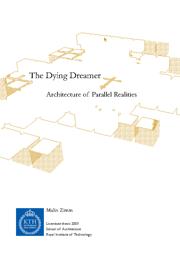The dying dreamer: architecture of parallel realities
Malin Zimm
2003
Technoetic Arts
The objective of the licentiate thesis is to investigate architectural experience and creation in virtual space and its representational problems. The thesis comprises three articles published during the years 2001-2003, and a website, featuring interactive illustrations and dramatized dialogues. The articles investigate architecture as a transgressive state between the virtual worlds of imagination and the domestic interior, introducing "obsessive dreambuilding" as a method of negotiating
more »
... ial fictions in real space. This type of architecture is studied through a selection of highly individual projects, each driven by their creator´s subjective desire verging on obsession, towards particular levels of architectural experience, both physical and virtual. The investigation leads into elaborate experiments in physical space, employing and developing artificiality and virtuality, as the creative mind pursues the desire for parallel realities. The main representative of this kind of architectural activity (the fictional character Baron des Esseintes in Joris-Karl Huysmans´ novel À Rebours from 1884) appears in all three articles. The first article, "The Dying Dreamer -Looking into Huysmans´ Virtual Worlds", is an analysis of the virtual architecture of the narrative space in Huysmans´ novel, investigating the relation between the spatial inventions in the narrative virtual reality of the novel and the conditions and terms associated with digital virtual reality. The second article, "The Operative Fields of the Artificial", focuses on the negotiation of artificiality through the layers of fiction in des Esseintes´ projects and the transitional character of his space, operating as an interface between his physical environment and his imagined virtual worlds. The third article, "The Obsessive Builder of Dreams", places the Baron in the company of three additional examples of obsessive dreambuilding, who share and develop the theme of the extreme individual project, and the particular eccentricity of the architectural imagination at work in the mind of the obsessive dreambuilder. This last article presents the architectural transformations created by Sir John Soane, Kurt Schwitters and Gregor Schneider. The architects of parallel realities are challenging our basic understanding of architectural organisation, aesthetics and methods by driving architectural space into different ontological states, providing a field for observation of perceptional and representational problems.
doi:10.1386/tear.1.1.61/0
fatcat:xugesaswbndnppnyd6m332d3ne

